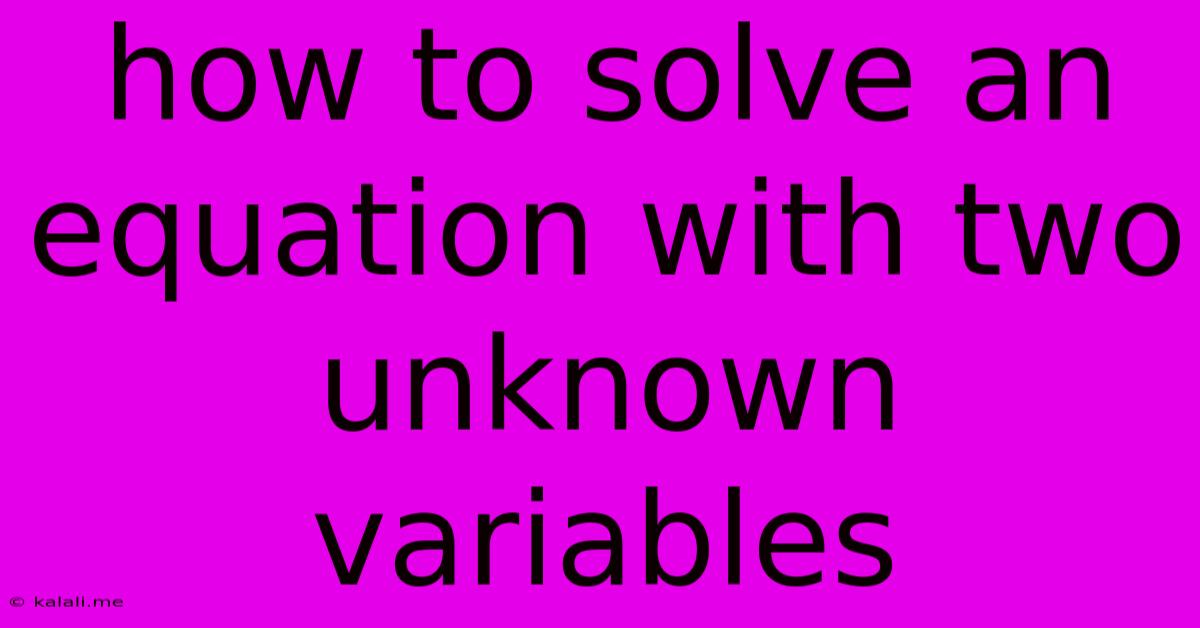How To Solve An Equation With Two Unknown Variables
Kalali
May 10, 2025 · 3 min read

Table of Contents
How to Solve an Equation with Two Unknown Variables
Solving an equation with two unknown variables, also known as a system of equations, requires more than simple algebraic manipulation. You need a set of equations, each containing the same variables, to find a unique solution (or solutions). This article explores different methods for solving these systems, focusing on understanding the underlying principles rather than just memorizing formulas. This guide will cover substitution, elimination, and graphical methods, providing you with the tools to tackle various equation types.
Understanding Systems of Equations: A system of equations is a collection of two or more equations with the same set of unknowns. The goal is to find values for these unknowns that satisfy all equations simultaneously. A simple example: x + y = 5 and x - y = 1. We need to find values for 'x' and 'y' that make both equations true.
Method 1: Substitution
The substitution method involves solving one equation for one variable in terms of the other, and then substituting that expression into the second equation. This leaves you with a single equation with one variable, which is easier to solve.
Steps:
-
Solve for one variable: Choose one equation and solve for one variable in terms of the other. For example, in the system x + y = 5 and x - y = 1, we can solve the first equation for x: x = 5 - y.
-
Substitute: Substitute this expression (5 - y) for x into the second equation: (5 - y) - y = 1.
-
Solve the resulting equation: Solve this equation for y: 5 - 2y = 1 => 2y = 4 => y = 2.
-
Substitute back: Substitute the value of y (2) back into either of the original equations to solve for x. Using x + y = 5, we get x + 2 = 5 => x = 3.
-
Check your solution: Verify your solution (x = 3, y = 2) by substituting these values into both original equations to ensure they are both true.
Method 2: Elimination (or Addition/Subtraction Method)
The elimination method, also known as the addition or subtraction method, involves manipulating the equations so that when they are added or subtracted, one variable is eliminated.
Steps:
-
Make coefficients opposites: Adjust the equations (by multiplying by a constant) so that the coefficients of one variable are opposites. For example, in the system 2x + y = 7 and x - y = 2, the 'y' coefficients are already opposites (+1 and -1).
-
Add or subtract: Add the equations together. In this case, adding the equations eliminates 'y': (2x + y) + (x - y) = 7 + 2 => 3x = 9 => x = 3.
-
Solve for the remaining variable: Solve the resulting equation for the remaining variable (x in this case).
-
Substitute back: Substitute the value of x (3) back into either of the original equations to solve for y. Using x - y = 2, we get 3 - y = 2 => y = 1.
-
Check your solution: Verify your solution (x = 3, y = 1) by substituting these values into both original equations.
Method 3: Graphical Method
The graphical method involves graphing both equations on the same coordinate plane. The point where the two lines intersect represents the solution to the system of equations. This method is particularly useful for visualizing the solution and understanding the relationship between the equations. However, it might be less accurate for equations with non-integer solutions.
Solving More Complex Systems: These methods can be extended to solve systems with more than two variables, though the process becomes more complex. Matrix methods (like Gaussian elimination or Cramer's rule) are often used for larger systems.
Conclusion: Solving equations with two unknown variables is a fundamental concept in algebra with applications across numerous fields. Mastering these methods – substitution, elimination, and graphical representation – will equip you with the tools to tackle various mathematical problems and further your understanding of algebraic concepts. Remember to always check your solutions to ensure accuracy.
Latest Posts
Latest Posts
-
How Many Months Is A Hundred Days
Jul 18, 2025
-
Mother And I Or Mother And Me
Jul 18, 2025
-
How Many Oz In One Water Bottle
Jul 18, 2025
-
How Many Dimes In A 5 Roll
Jul 18, 2025
-
How Do You Say Basil In Spanish
Jul 18, 2025
Related Post
Thank you for visiting our website which covers about How To Solve An Equation With Two Unknown Variables . We hope the information provided has been useful to you. Feel free to contact us if you have any questions or need further assistance. See you next time and don't miss to bookmark.